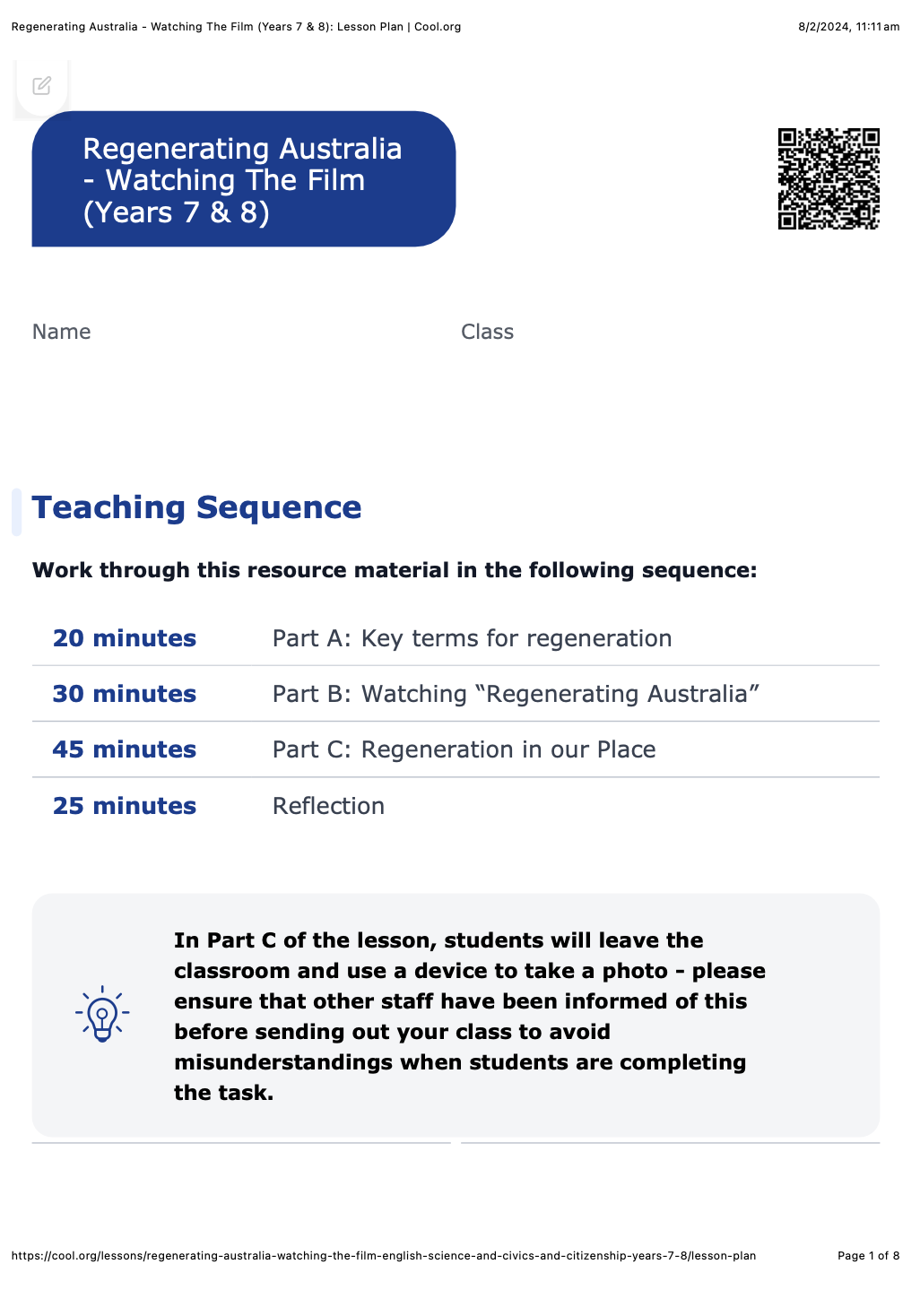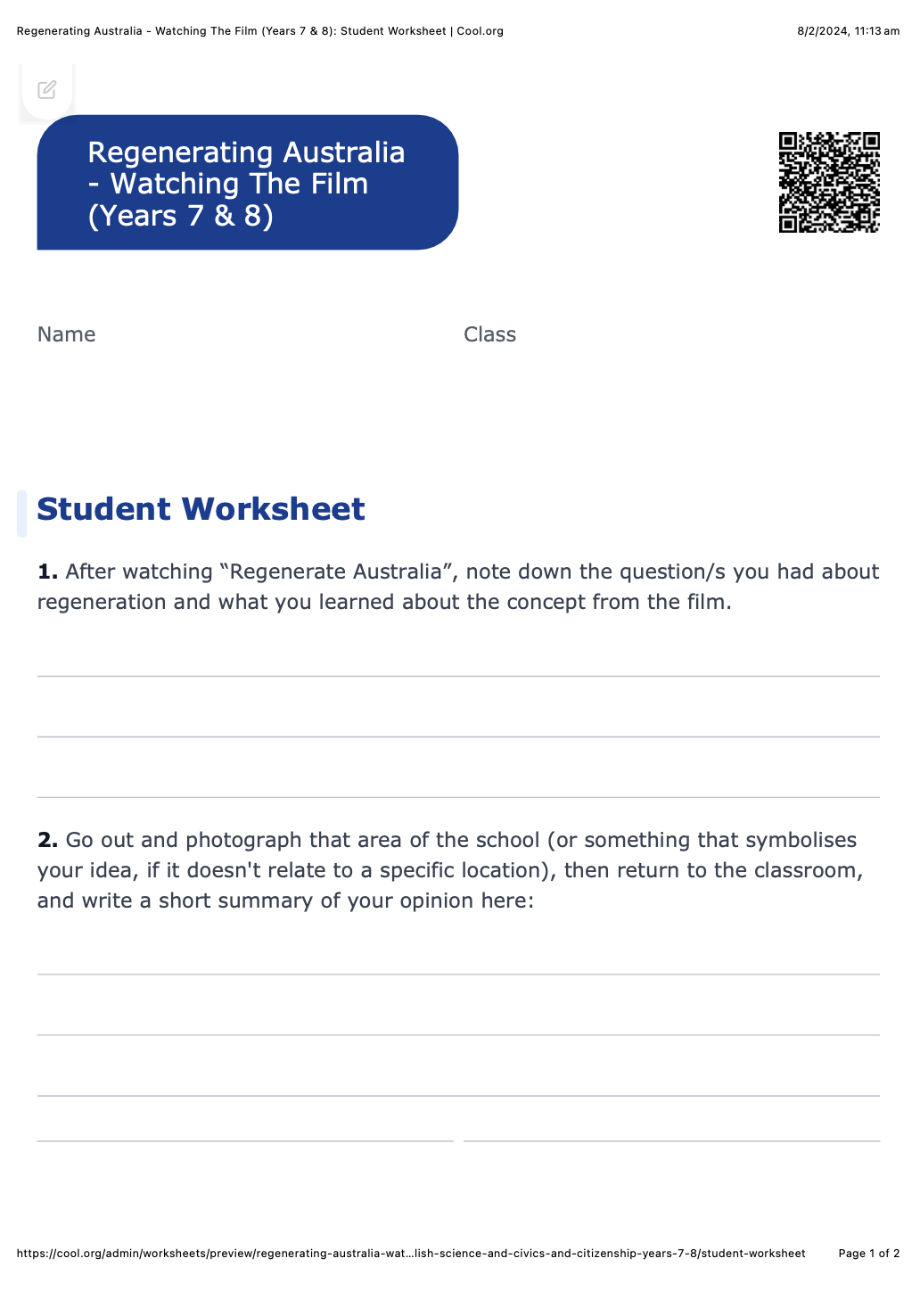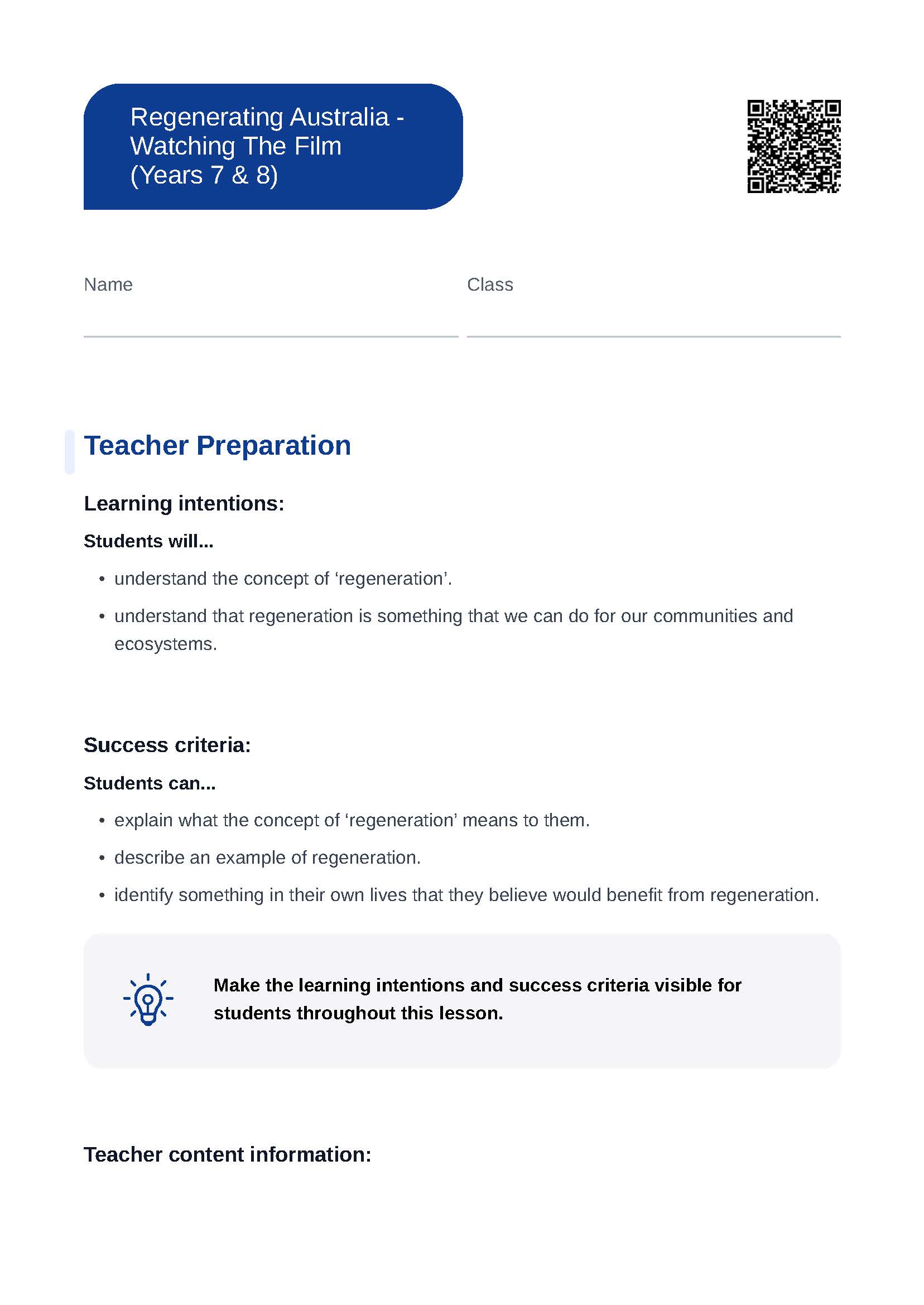Lesson summary
In this lesson, students will understand the concept of ‘regeneration’ and its impact on our communities and ecosystems. The teacher will activate children’s prior knowledge on the topic in a vocabulary matching game, prompt their critical thinking skills using the 5Ws, and invite students to develop questions about the concept of regeneration. They will view “Regenerating Australia”, then return to their questions and summarise the key themes. Students will be invited to explore their school with an open mind and capture spaces that could benefit from regeneration.
Learning intentions:
Students will...
- understand the concept of ‘regeneration’.
- understand that regeneration is something that we can do for our communities and ecosystems.
Success criteria:
Students can...
- explain what the concept of ‘regeneration’ means to them.
- describe an example of regeneration.
- identify something in their own lives that they believe would benefit from regeneration.
Lesson guides and printables
Lesson details
Curriculum mapping
Australian curriculum content descriptions:
Year 7 English:
- Use interaction skills when discussing and presenting ideas and information, selecting body language, voice qualities and other elements, (for example music and sound) to add interest and meaning (ACELY1804).
- Use prior knowledge and text processing strategies to interpret a range of types of texts (ACELY1722).
- Plan, draft and publish imaginative, informative and persuasive texts, selecting aspects of subject matter and particular language, visual, and audio features to convey information and ideas (ACELY1725).
Year 8 English:
- Use interaction skills for identified purposes, using voice and language conventions to suit different situations, selecting vocabulary, modulating voice and using elements such as music, images and sound for specific effects (ACELY1808).
- Apply increasing knowledge of vocabulary, text structures and language features to understand the content of texts (ACELY1733).
- Create imaginative, informative and persuasive texts that raise issues, report events and advance opinions, using deliberate language and textual choices, and including digital elements as appropriate (ACELY1736).
Year 7 Geography:
- Factors that influence the decisions people make about where to live and their perceptions of the liveability of places (ACHGK043).
- The influence of environmental quality on the liveability of places (ACHGK045).
- Strategies used to enhance the liveability of places, especially for young people, including examples from Australia and Europe (ACHGK047).
- Reflect on their learning to propose individual and collective action in response to a contemporary geographical challenge, taking account of environmental, economic and social considerations, and predict the expected outcomes of their proposal (ACHGS054).
Year 7 & 8 Health and Physical Education:
- Plan and implement strategies for connecting to natural and built environments to promote the health and wellbeing of their communities (ACPPS078).
Syllabus: EN4-3B, EN4-3B, EN4-4B, GE4-1, GE4-8, PDHPE4.9
General capabilities: Literacy
Cross-curriculum priority: Sustainability, Critical and Creative Thinking, Aboriginal and Torres Strait Islander Histories and Cultures
Relevant parts of Year 7 English achievement standards:
Students explain issues and ideas from a variety of sources, analysing supporting evidence and implied meaning. They make presentations and contribute actively to class and group discussions, using language features to engage the audience.
Relevant parts of Year 8 English achievement standards:
They listen for and identify different emphases in texts, using that understanding to elaborate on discussions. Students create texts for different purposes, selecting language to influence audience response. They make presentations and contribute actively to class and group discussions, using language patterns for effect.
Relevant parts of Year 7 Geography achievement standards:
Students describe geographical processes that influence the characteristics of places and how the characteristics of places are perceived and valued differently. They explain interconnections between people and places and environments and describe how these interconnections change places and environments. They describe alternative strategies to a geographical challenge referring to environmental, economic and social factors.
Relevant parts of Year 7 & 8 Health and Physical Education achievement standards:
Students examine how connecting to the environment can enhance health and wellbeing.
This lesson is part of the wider unit of work, Regenerating Australia.
Level of teacher scaffolding: High – support student movement around the classroom during learning activities and facilitate class discussions
Resources required
- Access to the film Regenerating Australia
- A device capable of taking and displaying a photo such as a smartphone, tablet or digital camera
- A device capable of presenting a film to the class
- Regeneration Factsheet – one copy per student
- Sticky notes – 5 per pair of students
- Student Worksheets – one copy per student
Skills
This lesson is designed to build students’ competencies in the following skills:
- Critical Thinking
- Creativity
- Communication
Additional info
Regenerating Australia is a Regen Studios film developed and produced in association with WWF-Australia. Cool.org and Regen Studios would like to acknowledge the generous contributions of Shark Island Foundation, Documentary Australia Foundation, and our philanthropic partners in the development of these teaching resources.




Welcome back!
Don't have an account yet?
Log in with:
By signing up to Cool.org you consent and agree to Cool's privacy policy to
store, manage and process your personal information. To read more, please see
our privacy policy here(Opens in new tab).
Create your free Cool.org account.
Many of our resources are free, with an option to upgrade to Cool+ for premium content.
Already have an account?
Sign up with:
By signing up to Cool.org you consent and agree to Cool's privacy policy to
store, manage and process your personal information. To read more, please see
our privacy policy here(Opens in new tab).